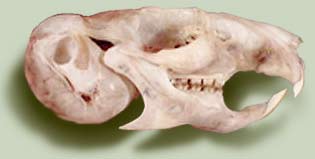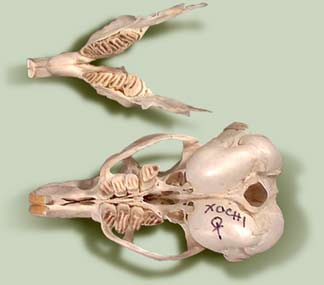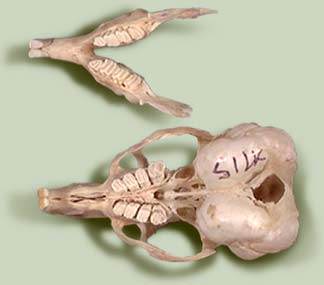Teeth

In the normal jaw, notice the even alignment of the molars, and how the upper incisors overlap the lower incisors. Note too the gap between the incisors and the molars, also called the cheek teeth. The teeth are not set into bone, as in the human jaw or some other mammals. So when the teeth are loose in their sockets, they can easily grow into the eye sockets, which are above the back three cheek teeth. Also note the large round bony structure in the back of the jaw. This is the ear space, bullae. It is approximately the size as in a human, so that you can see why the chinchilla's hearing is acute.

In this picture you see the gaps between the teeth and the jaw bone. This indicates loosening of the teeth in their connective tissue bases, and movement which results in points and spurs. Note the back molar in the upper jaw [top specimin]. This is a spur. It grows upwards rather than sideways. Note too the skewed lines of the molars, showing movment and improper grinding of the teeth, resulting in off centered tooth wearing and agian, causing points and spurs. The teeth in the upper jaw [bottom specimin] show a good view of a spur.
To prevent loosening of the teeth in the jaw, give a healthy young
chinchilla about 150-200 mg of vitamin C daily, [about the same
amount as guinea pigs] any way you can get it into your chinchilla.
Fresh oranges do not contain enough vitamin C in reliable amounts
for your chinchilla —bell peppers have more vitamin C, perhaps enough,
but daily amounts can concievably cause diarrhea. We recommend
finding a chewable vitamin your chinchilla will enjoy. Vitamin
drops in water are also NOT recommended for the following reasons:
• It is impossible
to determine the daily dosage your chinchilla will take in.
• Many chins will
stop drinking water in doses large enough to get proper amounts
of vitamins.
• In general, most
chinchillas do not need a multivitamin product.
• L
ight frequently decreases the potency of vitamins when put into
water bottles.
Chinchilla teeth are ever growing and need many products to help grind them down, such as good hay, good pellets [that are not too soft], pumice stones, wood to chew on etc. The grinding action is necessary for the tooth to maintain itself, and even grinding is based upon strong teeth in the sockets.
Abcesses & Other Dental Problems

In this picture, again note the spacing between the teeth in the upper jaw, and socket pockets [bottom specimen]. Chinchillas are prone to periodontal disease, to cavities, and to a scurvy-like loosening of connective tissue. They also can get abcesses in the pockets around the teeth. These abcesses, if left untreated, can cause a form of pneumonia in a chinchilla, which is why many chinchillas die from tooth problems. However, these problems are treatable by a veterinarian skilled in checking teeth. The teeth need to be cleaned out, and your animal needs an antibiotic.
Our practice has found that twice daily injections of Baytril for at least 14 days is a better way of treatment than the usual 10 day oral course. The animal is usually in pain after treatment, and will stop eating when in pain. [Woudn't you?] Give your animal around 12 hours to get over any bleeding from manipulation and cleaning, and give your animal some Pedilyte or other Sports Medicine Fluids to keep them from getting dehydrated.
Find a buffered Calcium-Ascorbate powder of Vitamin C, put about 2000 mg in a couple of teaspoons of baby food [preferabaly fruits], and give that for a few days. This raises the blood level of Vitamin C in your animal. You need to keep him well hydrated while he is on such high doses of C, and taper off after a few days. While the chin is being treated you should provide soft food. Make a soft food by grinding up your pellet in a blender, add a high-density nutrient-shake-powder and some baby food mix and enough Vitamin C to equal 500-1000 mg daily over the next month. Your animal might need to be fed by syringe at first. Keep your animal on soft food until the teeth heal, at which point your animal will want to chew on pellets.
Tooth problems are chronic. You and your vet will need to get to
know each other very well. For consultation, your vet
can call:
Dr. Wendy Beers
Mon. -Fri. / 9:00
am - 4:00 pm [Pacific Standard Time]
510.526.2053
» Please Note:
The Pictures on this page appear coutesy of Serena Goldyne, vet student at UC Davis. All pictures are from our animals, whose skulls we have collected, so that their deaths were not in vain.This is part of a California Chinchilla Association ongoing research project.
No animal was killed or hurt for the purposes of obtaining these pictures.
» Disclaimer: there are no studies on the intrinsic production of Vitamin C by Chinchillas. Are they closer to guinea pigs than to rabbits in this area? [added by request of Dr. Crossley, U.K.]